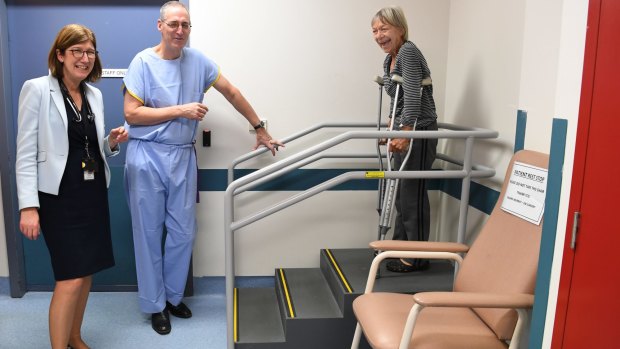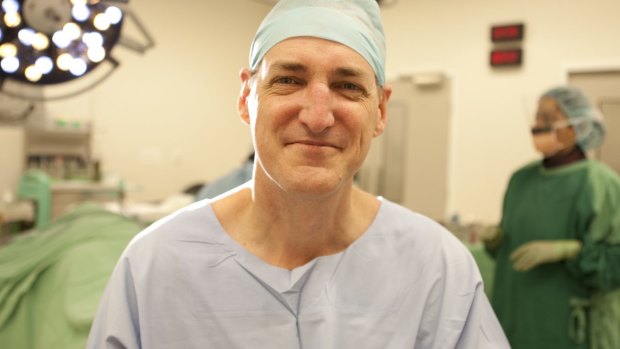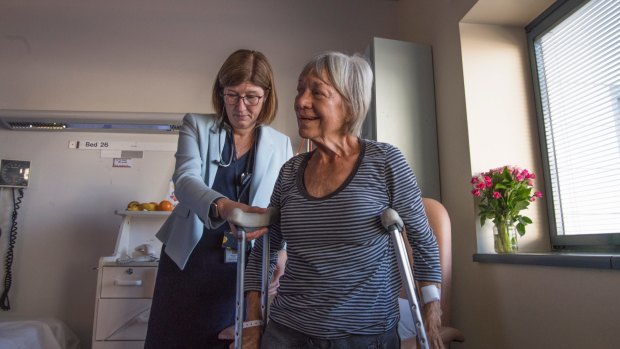This was published 7 years ago
Discharged from hospital, admitted to aged care: how hip fractures strip Australians of independence
By Kate Aubusson
Hip fracture patients face glaring gaps and huge variations in care that seriously impact their ability to recover and reclaim their independence, a major audit has found.
Five per cent of patients who break a hip will die in hospital, and up to 25 per cent will die within the year as a direct result of their injury, a major audit of the Australian and New Zealand Hip Fracture Registry (ANZHFR) found.
More than one in 10 patients will be discharged from hospital only to be admitted to an aged care facility as a result of their hip fracture, according to the report released Friday by Neuroscience Research Australia (NeuRA).
Half of hip fracture patients never fully regain their mobility, found the audit of 5178 hip fracture patients over 50 years old at 34 hospitals.

Professor Jaqueline Close, Professor Ian Harris and hip fracture patient Rhonda Wilson at Prince of Wales Hospital. Credit: Louise Kennerley
Hip fractures were devastating injuries for most patients orthogeriatrician Professor Jacqueline Close treats at Prince of Wales Hospital.
"Most people never go back to their previous level of function. It hugely impacts their quality of life," said Professor Close, an ANZHFR co-chair.
"One of the first things to go is your ability to go outdoors, for for physical but also psychological reasons," she said.
Patients are more frail than they were prior to the fracture, and the fear for falling was a powerful deterrent.

Professor Ian Harris said the priority for most older patients with hip fractures was to keep their autonomy.Credit: UNSW
Of the almost 3000 patients followed up 120 days after going to hospital, roughly one in five had gained back the mobility they had before their hip fracture.
Hip fractures are the most serious and costly injuries for falls among Australians over 50, with the cost set to rise in step with the ageing population.

Professor Jaqueline Close and hip fracture patient Rhonda Wilson.Credit: Louise Kennerley
The number of hip fractures is expected to rise from 22,000 to more than 30,000 by 2022, costing an estimated $1126 million per year, according to a recent Osteoporosis Australia burden of disease report.
The audit found wide variations in care between hospitals, from pain management strategies to how long patients waited for surgery and how quickly they were able to regain their mobility.
Roughly 50 per cent of hip fracture patients who came into hospital had already sustained a low-trauma fracture, yet only 20 per cent had been offered osteoporosis treatment, the audit found.
It was a monumental missed opportunity, Professor Close said.
"If we managed people who already had low-trauma fracture more efficiently we would make significant reduction to the rate of hip fracture in Australia," cutting fracture risk in the order of 30-60 per cent, Professor Close said.
"Australia hasn't woken up to this yet," she said.
Just 16 per cent of hip fracture patients in Australia receive osteoporosis treatment compared to 60 per cent in the United Kingdom, a recent UK audit showed.
The priority for most older patients with hip fractures was to keep their autonomy, said Sydney orthopaedic surgeon and registry co-chair Professor Ian Harris.
"They want to be in their own homes and they don't want to be a burden to their families," he said.
Improving all aspects of care, including access to a multidisciplinary team, appropriate treatment, timely surgery and rehabilitation and follow-up were integral to cutting the risk of loss of mobility and death, according to the report.
More than one in four patients were waiting longer than the recommended 48-hour window for surgery after fracture, and many were still waiting three days later, the audit found.
There were marked variations between operating room availability, Professor Harris said.
And while the majority of hospitals now aimed to get patients out of bed and weight-bearing the day after surgery, a significant proportion of patients were still not given the opportunity to do so, Professor Harris said.
"It varies a lot between hospitals," Professor Harris said; from two-thirds to 100 per cent of patients weight-bearing on their affected leg the day after surgery.
"The problem is patients aren't always getting access to physiotherapy services."
He hoped clinicians and hospitals would use the registry's real-time data that benchmarked their performance to improve the way they managed patients with hip fractures.
"We're also trying to create a voice for hip fracture patients. They have been neglected and not seen as a priority for a long time," he said.